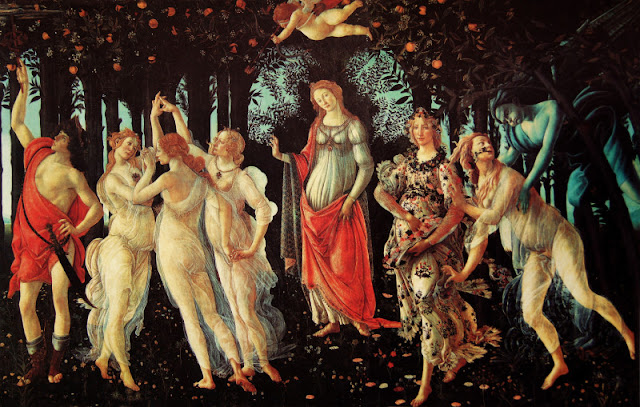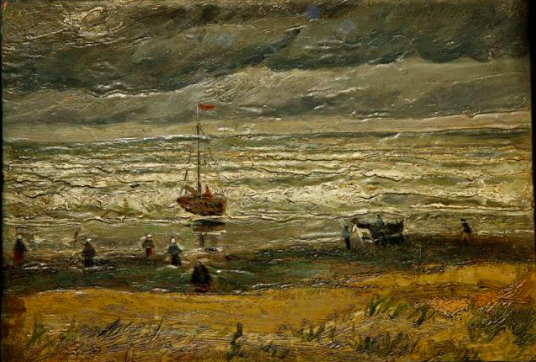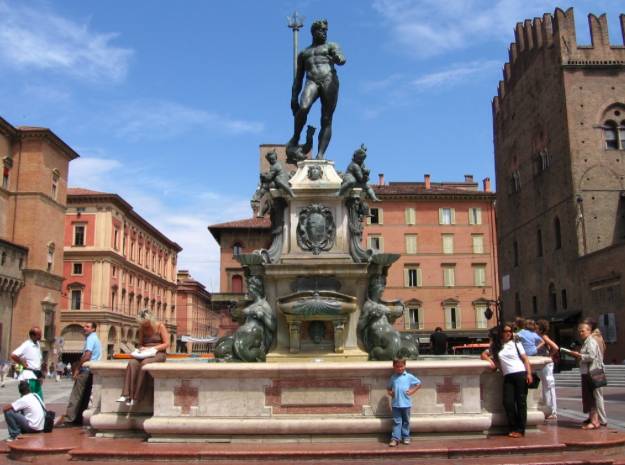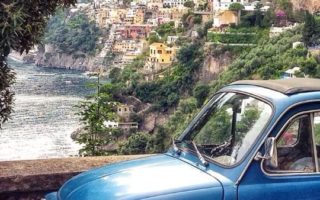Arty Italy – who knew?
 |
| Botticelli’s Allegory of Spring |
Food, wine and art are all synonymous with Italy. And as an Art History post-grad and a food and wine lover, these were all major influences for me, as well as the thousands of others, who chose to come to Italy.
The country is the birthplace of many world famous artists and THE country of Renaissance art. Even the least art savvy amongst us have heard of Michelangelo’s David, Botticelli’s Venus, the Sistine Chapel frescoes. Caravaggio and Canaletto. Regardless of whether you’ve studied art, have an interest in art, or have any clue about art – it’s fairly impossible not to be stunned into silence staring up at the Sistine Chapel ceiling or struck in awe at the gleaming figures seeming to step out of the canvas in Caravaggio’s paintings.
The art geek in me could quite easily get carried away discussing any one of these themes, but to keep this accessible, and of course interesting, I’ve decided to compile various facts and stories that I was drawn to, all relating to the world of art in Italy. So here goes, get your art on…
1. Stolen Van Gogh paintings revealed in Naples after 14 years in hiding…

Last year, what the FBI named as one the global top ten art crimes, was finally solved after the raid of a country mansion, described as a mafia stronghold, outside of Naples. Fourteen years ago in 2002 two daring criminals climbed onto the roof of the Van Gogh museum in Amsterdam early one morning, broke in and stole two major works by the artist from the beginning of his career which were worth €100 million. The men escaped leaving just a ladder and rope as proof of their crime. Thanks to DNA, both thieves were later caught and given prison sentences, meanwhile the two paintings were seemingly lost forever. Yet, fourteen years later after what undoubtedly seemed a never ending investigation, police in Naples proudly revealed the recovery of these two works. Discovered unframed, wrapped in cloth yet unharmed – you can now see the paintings back on display after their extended ordeal, in their original home in Amsterdam.
2. Italian written masterpiece given marble form…

Most of us have at least heard of Auguste Rodin’s sculpture ‘The Kiss’ and Dante’s poem ‘Inferno’. Both, truly masterpieces of their respective creative forms. Yet how many knew the connection between the two? Rodin was a fan of Dante’s ‘Inferno’ and took inspiration for his most famous sculpture from the ‘Divine Comedy’. As the story goes, an Italian noblewoman Francesca da Rimini falls in love with her brother-in-law, but both are dramatically discovered and killed by her husband before their affair has chance to grow. And Rodin’s sculpture mirrors this unfulfilled desire as the couple whose bodies are entwined are not in fact kissing as the title would suggest. They are now forever locked in marble in an intimate embrace that will never quite become the kiss that the two desired.
3. Who doesn’t want to be a Roman Emperor?

We’ve all thought about it right? Toga and sandals, olive-leaf head wreath, speeding on a horse drawn chariot, reclining in a marble clad room, grapes dangled decadently at mouths reach… turns out it’s not a modern day contemplation, but go back five hundred years and artists were also dreaming of life as a Roman Emperor. However, these artists did more than simply model themselves on their ancient counterparts, they aspired to rival them. An idolisation of the ancients often became an obsession to outdo. One fascinating example the sixteenth century artist Andrea Mantegna who designed his own memorial in the Chapel of San Giovanni Battista in Mantua (1561) in which he portrayed himself like a Roman Emperor in the classic bust style and with these words surrounding: “You who see the bronze images of Andrea Mantegna know him to be equal, if not superior to Apelles”. Pretty gutsy and pretty self-assured to rate himself above the ancient Roman greats!
4. A double bluff robbery of a double portrait…

Now this story is brilliant, but it requires some concentration. Its a puff pastry of layers to get your head around. But well worth it. In 1997 in the small Italian town of Piacenza local 18 year old art student Claudia Maga noticed something quite incredible about the Ricci-Oddi gallery’s painting ‘Portrait of a Lady’ by Gustav Klimt. She noted the incredible similarity in face of this woman and another portrait ‘Portrait of a Young Lady’ that had last been seen in 1912. X-rays revealed her theory correct – this was in fact Klimt’s only known double portrait; that when his muse, the original young lady, had died, the artist decided the best way to deal with the pain of loss was to paint over her portrait with a new lady.
With such an exciting discovery, the gallery, which was undergoing renovations at the time, began arrangements for a celebratory exhibition in a different location in the town. With all the to-ing and fro-ing, coming and going, it was perhaps understandable that when the painting went missing, it wasn’t immediately picked up on.
5. Practicalities over aesthetics…

Undoubtedly one of Italy’s most famed and visited artworks – ‘The Last Supper’ by Leonardo da Vinci is now considered a masterpiece of the Renaissance, yet it hasn’t always been revered and respected in the same way. Finished in 1498 in what used to be the refractory of the monastery of Santa Maria delle Grazie in Milan, did those Monks ever imagine that their mealtime setting would attract hundreds of thousands of visitors hundreds of years later?
6. Cover the nude!

Final fact is a silly one, but an interesting reflection on society nowadays, social media and the its relationship with the past. For the past 500 years Piazza del Nettuno in Bologna has been the home to the huge bronze statue of the sea god Neptune. Like countless statues across Italy, Neptune is nude; something which recently caused an online controversy. A local writer used an image of the statue on her Facebook page, and the image was censored by Facebook for being ‘sexually explicit’. Thankfully, following complaints, Facebook acknowledged that Neptune is an artwork with historical and cultural importance and withdrew their censorship.

